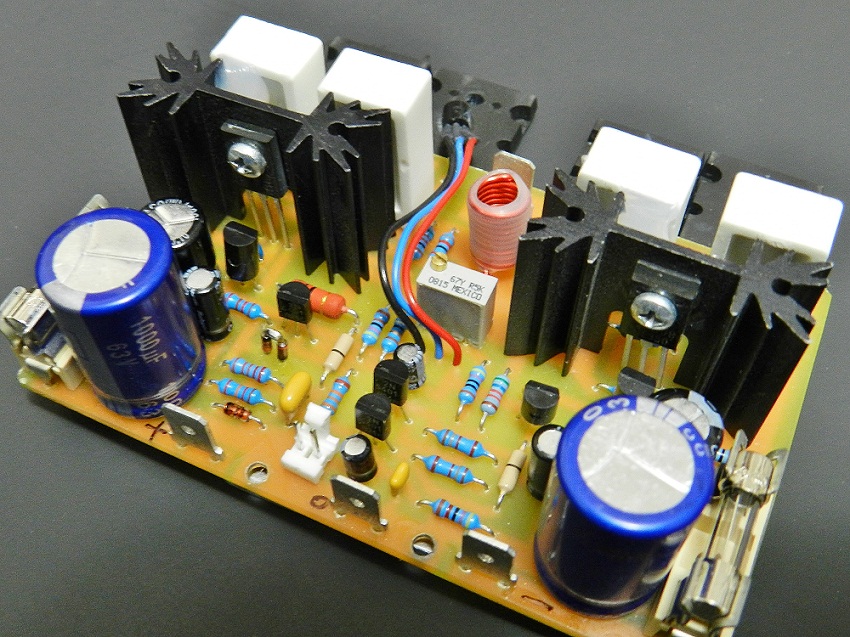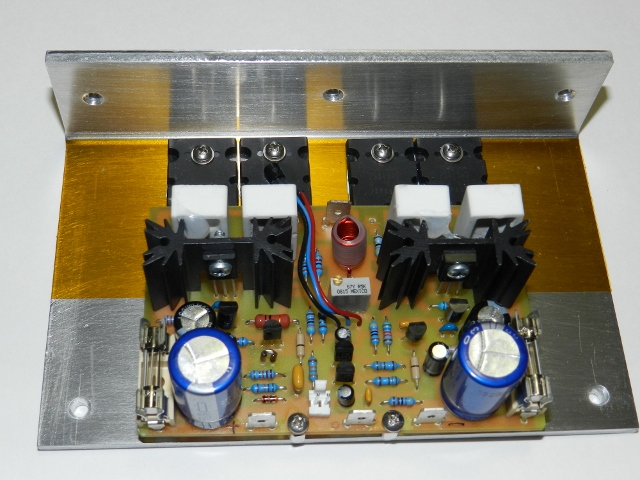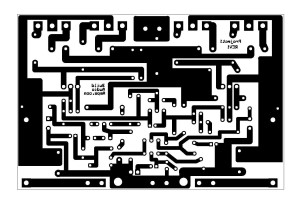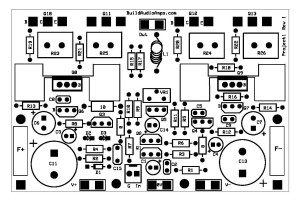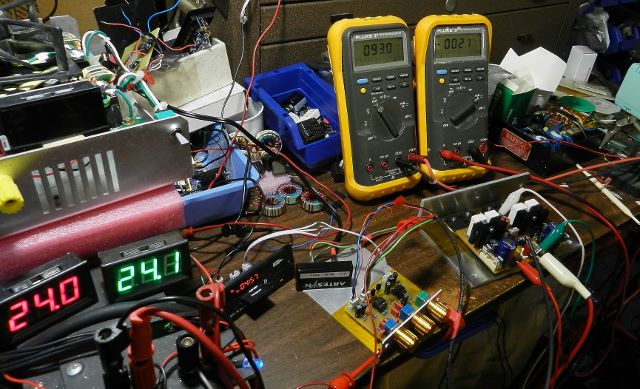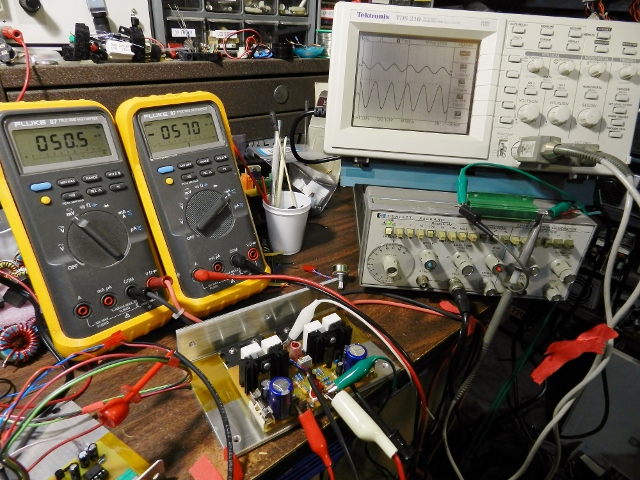Project 1
I’d like to share this simple audio amplifier circuit with you as the first project in the website. I built the model unit conservatively using what's available in The Parts Bin: 2 pairs of 2SC5200 and 2SA1943 or 2SC5242 and 2SA1962.
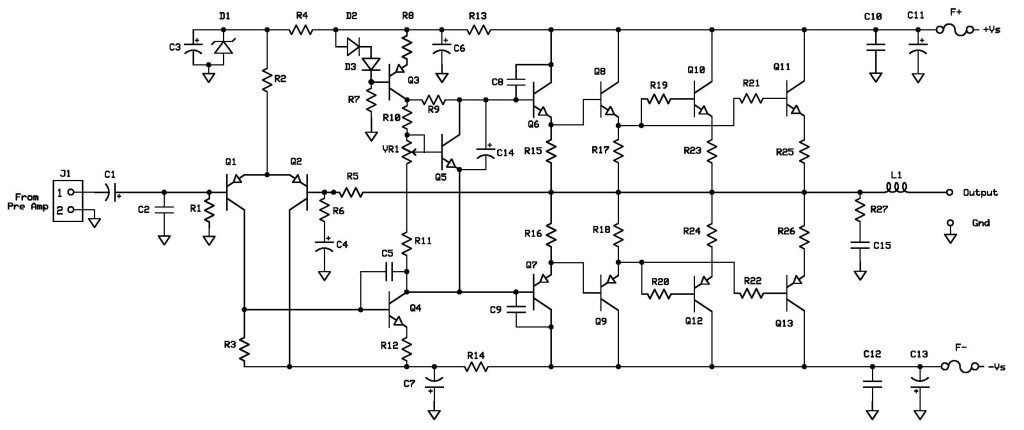 Schematic Diagram of Project 1.
Schematic Diagram of Project 1.
Here's a brief description of the circuit:
The input stage is a differential amplifier circuit also called long-tailed pair consisting of Q1 and Q2. The input signal is applied to the base of Q1 and the feedback signal coming from the output of the amplifier is applied to the base of Q2. R5 and R6 in series with C4 determines the overall gain of the amplifier. Q4 is the voltage amplifier stage, loaded by a current-source circuit Q3 along with D2 and D3. C5 is for high frequency compensation. The Vbe multiplier Q5, is populated off the PCB and attached to one of the power transistors for thermal feedback. The idle current of the amplifier is adjusted by VR1. Power output stage drivers Q6, 7, 8 and 9 are configured as emitter followers. Q10, 11, 12 and 13 are full complementary push pull parallel output stage power transistors. The emitter resistors R23, 24, 25 and 26 in the power output transistors are necessary for thermal stability. L1, R27 and C15 improves stability of the amplifier at any loads. The main power supply rails of the amplifier are ±45VDC.
A PCB layout and Bill Of Materials (Project1 BOM) for this project are provided for free, as is, no warranty.
After completion of the circuit board assembly you need to adjust the idle current of the amplifier. If you have a ±24VDC power supply use that for testing. This is where all your DMMs come in handy. Two DMMs to monitor the ±24VDC power supply, another one to monitor the DC offset voltage and another one to measure the idle current of the amplifier.
Why all the DMMs? The very first time you apply power to a newly built audio amplifier project the DMM is your best friend. The DMM tells you if there is something wrong with your circuit board assembly. A very high ammeter reading indicates that a component in the circuit is drawing too much current. The same goes with a very high voltage reading at the output of the amplifier where you should expect a very low voltage reading in the millivolts range. The DMM tells you the bad news and when that happens you immediately switch OFF the power supply and recheck the assembly. If you don't have a DMM when that happens, you have only your senses to tell you something is burning and that smoke signals are coming from the PCB.
With the power OFF, remove F+ fuse and insert a milliammeter* at the fuse terminals. Connect a shorting jumper or shunt at J1. Connect a millivoltmeter* at the output pcb terminal and ground. Adjust VR1 to read minimum resistance or 0Ω in the ohmmeter*. VR1 can be accessed at one end of R10 and R11. When everything has been set up, switch the power supply to ON. If you did a good job, the millivoltmeter* connected at amplifier’s output will read some DC voltage value and goes back to about 50mV or less, this is the DC offset voltage. The voltmeters* connected at the power supply rails should read whatever voltage you apply to the amplifier under test and should not change. Adjust VR1 to read 20 mA on the milliammeter* connected at the F+ fuse terminals, this is the idle current of the amplifier. After a warm-up period of 30 minutes readjust idle current to about 35 mA.
If your test results were different from aforementioned, turn OFF power supply immediately. Take a deep breath and relax! Inspect the PCB for correct parts placements, solder bridge and etc. When you have discovered the problem, repeat the same test procedure. If all goes well proceed with the music test.
The project works fine at ±24VDC with amazing results. If you plan to use a higher power supply voltage do not exceed the maximum voltage rating of C11 and C13.
The LM1036 tone control project when paired with this project produces excellent results!
Figure 1. Project1 mounted on a 0.185" aluminum-mounting bracket, which can be attached to an extruded heatsink.
Figure 2. Bottom Copper Layer of PCB.
Figure 3. Silkscreen Parts Placement Layer of PCB.
Figure 4. Initial test of Project1 using +/-24VDC power supply, excuse 'bench clutter!
Figure 5. More Project1 tests using DMMs, Function Generator and Oscilloscope: 50mV DC Offset, 570mA current at F+ and with a 1Vp-p 1KHz sine wave input signal, produces 20Vp-p across an 8Ω 100Watt load.
*this refers to one of the basic functions of a DMM.

